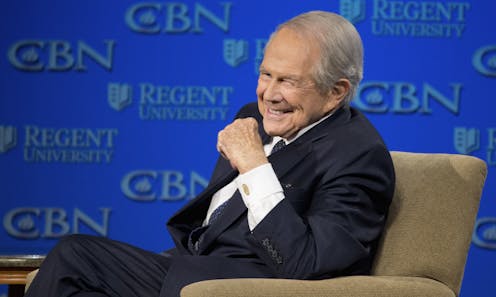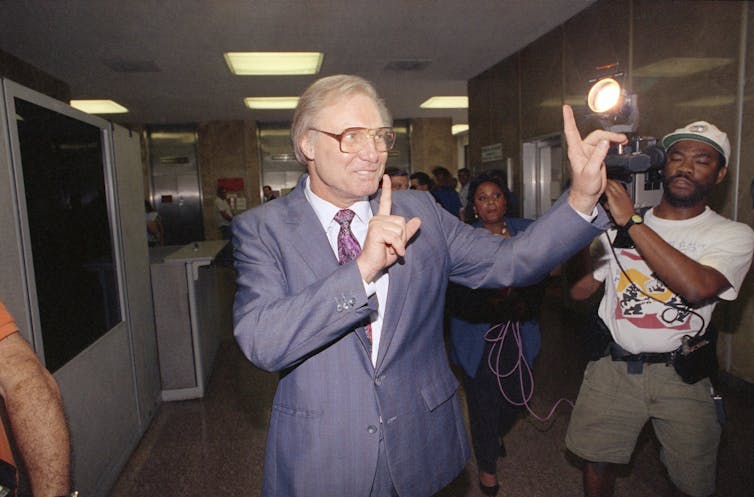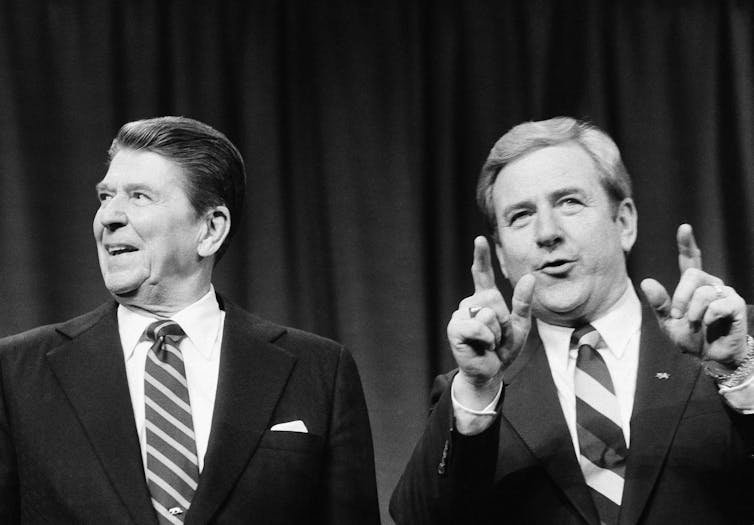How Pat Robertson changed Christian media and made it politically influential
A scholar of religion and politics explains how Robertson led the way in blending religion with political commentary and paved the way for a wider influence of Christian media on American culture.

For Americans growing up between the 1950s and the 1980s, religion was a predictable presence on television: There were weekly Sunday morning shows and religious programming that issued end-time warnings, sought monetary contributions or staged faith healings. But none of those covered news.
Pat Robertson, who died on June 8, 2023, changed this. Today, there are entire networks devoted to religious broadcasting, which include Christian television that reaches millions of Americans, often with a conservative perspective on current events.
As a scholar of religion and politics in America, I believe it is important to understand the impact of the medium, and how it came to have such influence.
The growth of Christian media
American Christians have historically used new media to spread the gospel. In the 19th century, evangelicals used pamphlets and advertising techniques. The early 20th century produced a religious radio subculture that is still thriving in programs like the ones offered by Focus on the Family or Moody Radio.
By the early 1950s, preachers like Robert Schuller and Billy Graham had energetically taken to television. Such programming thrived during the Cold War, and in 1966, Robertson’s “The 700 Club” debuted.
“The 700 Club” was distinct from other programs in its willingness to blend theological themes with political commentary and explicit engagement with news. In the 1970s, this approach became more widespread because of two related political trends.
First, Protestant organizations, mostly fundamentalist ones like the Moral Majority, took to popularizing Christian conservatism. These organizations rallied national support to influence politicians to oppose abortion rights and the Equal Rights Amendment, among other causes.
Second, around the same time, beginning with Ronald Reagan’s presidency, conservative politicians started to harness evangelicals as a voting bloc. As a result, many of these politicians began paying closer attention to Robertson for indications of this bloc’s concerns.
The televangelists
These political changes were reflected in the rapid growth of Christian shows on cable television.
In addition to Robertson’s long-standing talk show, the end-times prophecy show “Jack Van Impe Presents” and others began to normalize the idea of addressing what was happening in the news from a Biblical perspective. Such shows claimed they were providing viewers with “real” explanations that media and liberal politicians covered up. These shows also presented conservative talking points as facts.

During this period, American “televangelists” experienced several withering scandals. Evangelist Jimmy Swaggart, for example, was discovered with a prostitute, and televangelist Jim Bakker was convicted of fraud.
In the long term, however, these scandals did little to diminish the influence of such preachers. Robertson’s story demonstrates this.
To the surprise of many, Robertson entered the Republican presidential primary in 1988. Though he dropped out of the race somewhat early, his candidacy might have helped prove that far-right evangelicalism was now anything but marginal. Following this, Robertson co-founded, along with Ralph Reed, the Christian Coalition, which worked to advance politically many of the key issues circulated in Christian media, such as concerns about abortion, anxiety around religious pluralism, and contesting the secularization of public institutions.
Influence of Christian media
Religious broadcasting grew hugely in the 1990s and 2000s. Christian media increasingly commented on current events. And, critically, it began to have an influence on the wider culture.
For example, from the mid-1990s, popular films and novels like “Left Behind” suggested that viewers with the “wrong” religious or political beliefs would suffer damnation. Such films and literature attracted tens of millions of viewers and readers.
Furthermore, the kinds of issues and arguments long advanced in Christian media – such as concerns about the content of popular entertainment, or resistance to changing family dynamics – regularly exploded into widespread public concern, and conservative critics began to influence political policy.
“The 700 Club” and the Christian Broadcasting Network regularly devoted airtime to critiques of educational policy, which in time gained ground in the Republican Party. Robertson was also instrumental in popularizing Christian schools, like his Regent University, rooted in the idea that public institutions were not trustworthy.
Why this matters
The power of these programs is more than simply the stories covered or guests interviewed – it is their social impact on religious beliefs.
At times, Christian news can present ideas that are often highly emotional and conspiratorial as facts. For example, on election night in 2016, Robertson floated the idea that Planned Parenthood founder Margaret Sanger conspired with Martin Luther King Jr., to orchestrate “black genocide.”
This way of viewing the world moved closer to the center of conservative politics since the 1980s, a period of time when the Christian right acquired more influence in American politics.
The themes central to Christian television were more consistently those of the Republican Party. Consider how in some corners of the media in the 1980s, Reagan began to be depicted as though he was God’s agent on Earth. In the 1990s, the growth of multinational corporations and trade deals was decried as part of a demonic “new world order.” And today, when Islamophobia is on the rise, some Christian television channels often depict and celebrate former President Donald Trump as a “fighter in chief” who defends Christians despite his personal faults.

These attitudes were reflected in many of the contemporary news programs themselves.
For example, Robert Jeffress of Dallas’ First Baptist Church called Islam a “false religion” that is “inspired by Satan himself.” Such claims have been widespread since Sept. 11, 2001, alongside assertions - made by Robertson and Jerry Falwell two days after that event – that the attacks had occurred because America expanded gay rights, legalized abortion and removed prayer from schools.
Such comments reached millions of people without facts ever being addressed.
Further, Christian Broadcasting Network news regularly featured stories about Christians persecuted globally, such as in Turkey.
While such persecution clearly does occur in places across the world, CBN and other outlets often framed these stories alongside claims that American Christians were censored or otherwise embattled by liberalism or secularism. These latter claims helped produce an overall sense that Christians were beleaguered in America.
Amplifying one view?
The growing regularity of such examples has significant implications for American politics.
First, assertions that religious liberty is being violated around the world are put out endlessly in what I call “the resonance chamber of American public life,” in which repetition, aided by social media, helps claims to achieve legitimacy. Second, stories on the Christian news channels are constantly tailored to the idea that viewers are being persecuted.
By presenting itself as authoritative, trustworthy journalism, Christian news reassures viewers that they do not need to consult mainstream media in order to be informed. More dangerously, I argue, it authorizes a particular, often conspiratorial way of viewing the world. It denounces neutrality or accountability to multiple constituencies as burdensome or even hostile to Christian faith.
This is an updated version of an article first published on May 25, 2018.
Jason C. Bivins does not work for, consult, own shares in or receive funding from any company or organization that would benefit from this article, and has disclosed no relevant affiliations beyond their academic appointment.
Read These Next
Karoline Leavitt’s White House briefing doublethink is straight out of Orwell’s ‘1984’
A historian analyzes how White House press secretary Karoline Leavitt’s claims about her boss and…
Billionaires with $1 salaries – and other legal tax dodges the ultrawealthy use to keep their riches
The richest Americans can largely avoid paying income and other taxes. A new book explains the history.
The US already faces a health care workforce shortage – immigration policy could make it worse
About 1 in 4 doctors practicing in the US were born abroad.





